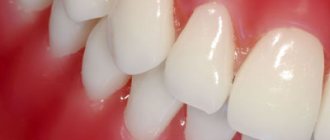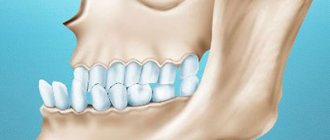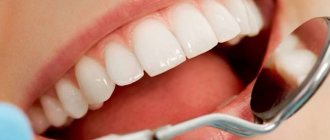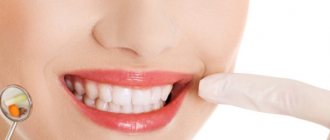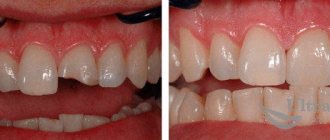After installing a filling, artistic restoration with composite materials, or professional cleaning, teeth must be polished.
The tasks in each case are different, but the meaning is the same: to make the surface as smooth as possible, to remove microcracks, the smallest protrusions and grooves. The smoother the surface, the fewer bacteria there are, which means the lower the risk of infections and inflammation in the oral cavity.
- When used:
polishing restorations and fillings; after hygiene - Treatment period:
as needed - Type of anesthesia:
not required - Procedure time:
up to 40 minutes - Age restrictions:
from 18 years old (in our clinic)
Goals of the procedure
Composite restorations are polished to prevent the accumulation of bacteria in small cracks, and fillings are polished to smooth the transition between it and dentin and correct microdefects.
Grinding and polishing the enamel is the final stage of hygienic teeth cleaning and plaque removal. After the teeth are freed from deposits, their surface becomes rough, and microcracks appear in the dentin. This is a guarantee that plaque will form again and quite quickly. Polishing your teeth after brushing removes minor defects and remaining mineral deposits, preventing the formation of stone.
Finishing the filling. Manual
The rotation speed and the force of pressure on the working surface are the main parameters on which the final result of finishing the restoration depends. Turbine tips develop rotation speeds from 350,000 to 450,000 rpm. Finishing diamond and carbide burs and polishing stones can be used with turbine tips. The force of pressure on the working tool should not be large (less than 1 Newton), since excessive pressure at such a speed will lead to sudden overheating of tooth tissue, cracking of the filling surface, and damage to healthy enamel. All turbine finishing tools require adequate water cooling (average 30-40 ml/min).
The speed of the contra-angle handpieces directly depends on the type of micromotor and the reduction coefficient. Pneumatic micromotors have a minimum rotation speed of 2000 to 5000 revolutions and a maximum speed of 20,000 revolutions. For electric micromotors, these parameters range from 60 to 40,000 rpm, respectively.
The operating speed of most finishing tools ranges from 2,000 to 10,000 rpm, with an average of 5,000 rpm. At this speed, a tip without reduction (1:1), as a rule, does not have enough torque (torque), which reduces the efficiency of processing the filling. Increasing the speed leads to the same problems as when working with turbine tips. For pneumatic micromotors, the optimal contra-angle reduction is 4:1, for electric micromotors - 8:1. The maximum rotation speed of the tool in the handpiece is 5000 rpm with powerful torque. Finishing at these speeds can be done with or without water cooling depending on the type of tool.
STEPS OF FINAL PROCESSING OF FILLINGS
The idea of finishing fillings in the form of grinding and polishing stages does not correspond to the current state of affairs in this area. Since the correct sequence of processing a filling largely determines its quality, the main stages of finishing restorations are presented below (Fig. 2):
1. Contouring of the filling (rough initial processing) is carried out with highly abrasive tools using turbine and contra-angle tips.
2. Formation of the final anatomical shape of the filling (occlusal and proximal correction) is carried out with instruments with standard abrasiveness using turbine and angled tips. Assessment of occlusal relationships is carried out using a special
Are there any contraindications
There are no contraindications for polishing teeth, but procedures that precede this do have them.
For ultrasonic cleaning:
- presence of a pacemaker;
- treatment with immunosuppressants and corticosteroids;
- recent eye surgery;
- epilepsy;
- severe form of diabetes.
For AirFlow:
- taking medications for salt balance;
- hepatitis;
- AIDS;
- sodium-free diet;
- lung diseases, asthma.
In case of infections, diseases of the upper respiratory tract, exacerbation of general conditions, or the presence of ulcers in the mouth, it is worth postponing resurfacing until the condition improves.
How do we do this?
Our specialists will painlessly, efficiently and reliably carry out re-filling. The doctor will select the color and model the shape of the new filling. Filling materials are like paints in an artist’s palette: they can be selected individually for a specific case, for each person, and the color, brightness and transparency of the tooth can be very carefully adjusted. Filling occurs in layers, taking into account the anatomical features of the tooth. As a result, the work of a dentist is not noticeable to others.
Nowadays, the latest filling materials are widely used for dental treatment, which help to cope with several tasks at once - therapeutic, aesthetic and preventive. Their number is growing from year to year, and the quality is improving, which allows us to do better and better work.
However, remember, dear patients, that not in all cases you can limit yourself to replacing the filling. If the destruction process is too advanced, you will be offered a ceramic orthopedic inlay or crown instead of a filling. These materials are more reliable and durable, and will help extend the life of your tooth for a long time. In any case, after a preliminary consultation, our specialists will be able to choose the best option for you.
What is used
After removing plaque with ultrasound or an air-abrasive device (AirFlow), the dentist begins grinding the teeth.
For this we use:
- Special polishing attachments.
Rubber cups are filled with abrasive paste and all surfaces are thoroughly treated. To treat the tooth crown after the cup, brushes are used. - Strips.
To polish between the teeth, dental tapes (strips) are used. They do this very carefully, trying not to damage the gums. - Abrasive pastes.
To enhance the abrasive effect, use: - Zircon:
an abrasive that perfectly removes age spots and yellowness in smokers. - Silicon dioxide:
suitable for post-scaling polishing, fillings and artistic restorations - Aluminum hydroxide:
depending on particle size, used for both plaque removal and final polishing - Titanium dioxide:
polishes enamel and closes tubules in dentin
Dental filling. Filling technique
As you know, the most common materials for filling teeth are light-curing composites. Taking this fact into account, let’s consider the technology for installing a photocomposite filling.
The method of filling a tooth directly depends on the volume and depth of the carious process. Based on the depth of the carious cavity, caries is classified as: superficial, medium and deep. With superficial caries, the carious defect is located within the enamel. In moderate cases, the enamel is affected and the dentin is affected. With deep caries, the enamel is damaged and a significant layer of dentin is destroyed by caries.
Superficial caries
Average caries
Deep caries
After the carious cavity is prepared for filling, the tooth must be isolated from saliva. Failure to comply with this requirement can lead to wetting of the prepared cavity with saliva and, as a result, cause a violation of the tightness of the filling to the tooth. This leads to caries at the interface between the filling and the tooth, and can also cause the dental filling to “fall out”.
To isolate teeth from saliva, cotton swabs are used, or a more reliable method is isolation using a rubber dam. A rubber dam (or rubber dam) is a thin sheet of latex rubber. Using a special technique, the rubber dam sheet is placed on the tooth, creating a dry working field. Saliva is removed from the mouth using a saliva ejector.
Figure 1: Rubber dam sheet.
Fig. 2: Clasps are metal clips for fixing the rubber dam to the tooth.
Figure 3: Tooth isolated with rubber dam.
Then acid etching of the prepared cavity is carried out using 37% phosphoric acid. This is done in order to remove the so-called “smear layer” and increase the contact area between the surface of the tooth cavity and the filling. During etching, the acid dissolves the inorganic components of the tooth tissue, creating a rough surface. After 20–60 seconds, the acid is washed off with water and the tooth is dried with air.
The next step is to introduce the so-called “bond” into the cavity - its function is to create an “adhesive” layer for reliable “adhesion” of the filling to the tooth tissue.
Applying bond to the walls of the prepared cavity
After bonding, the walls of the cavity are covered with a special special flowable composite. Thanks to its fluidity, it penetrates into all microcavities, creating a thin and smooth “adaptive” layer. This layer helps relieve mechanical stress from the walls of the tooth cavity. Then the flowable composite introduced into the cavity is cured with the light of a special dental lamp.
Dental curing lamp
Light curing of fillings
The filling material is directly introduced into the cavity in portions and evenly distributed in it. After which it is cured with lamp light. So, layer by layer, the entire cavity is filled. It is very important that the thickness of each layer does not exceed 2 mm. This requirement is associated with polymerization shrinkage of the photocomposite (reduction in volume during curing) and the inability to polymerize a “thick” layer of the composite with lamp light. If this rule is not followed, a microgap may form between the filling and the tooth tissue, which leads to recurrent caries. This mistake can also cause pain after the filling is placed.
So, the light seal is “installed”. Now it should be processed, i.e. give the restored tooth the correct anatomical shape and polish the filling. Pre-treatment of the filling is carried out using diamond or carbide burs. Excess filling material is removed, sharp edges are smoothed, and the filling is given a relief characteristic of a given tooth. To control the full contact between the restored tooth and the antagonist (a similar tooth in the opposite jaw), carbon paper is used. When the teeth are closed, the paper leaves an imprint on the filling in the place where the contact is excessive. This point is sanded. This operation is repeated until optimal contact between the antagonists is achieved. For final processing of the filling, polishing rubber bands, abrasive discs and strips are used. After which the filling is polished with a special polishing paste and coated with a protective varnish.
Clinical example of dental restoration with heliocomposite
A: Initial situation (amalgam fillings requiring replacement).
B: The fillings are removed and the resulting cavities are etched and covered with bonding agent.
C, D, E: Stages of restoration of the second upper premolar.
Type of completed dental restoration
Features of treatment of medium and deep caries
In medium and, especially, deep caries, the layer of tooth tissue separating the bottom of the carious cavity from the pulp chamber (the inner part of the tooth where the “nerve” is located) can be very thin. As a result, after placing a filling, a complication may occur - pulpitis (inflammation of the nerve of the tooth). Pulpitis, in this case, can be provoked by chemical irritation of the pulp by dental preparations used to treat the carious cavity.
Also, a significant area of exposed dentin (the inner tissue of the tooth containing nerve endings) can cause pain after tooth filling. In order to prevent these undesirable consequences, before placing a filling, the inner surface of the prepared cavity is covered with a thin layer of glass ionomer cement. The cement layer promotes the regeneration of tooth tissue and isolates sensitive dentin from the irritating effect of the etchant acid.
In case of deep caries, a special therapeutic pad is applied to the bottom of the cavity. It contains calcium hydroxide, which helps restore dentin from the pulp chamber. Then a layer of glass ionomer cement is applied over the treatment pad, after which a filling is placed.
A “good” filling will be obtained if the above principles of caries treatment are observed. In other cases, the filling will most likely not be “good” enough.



